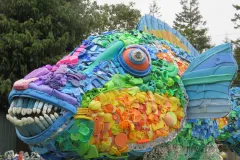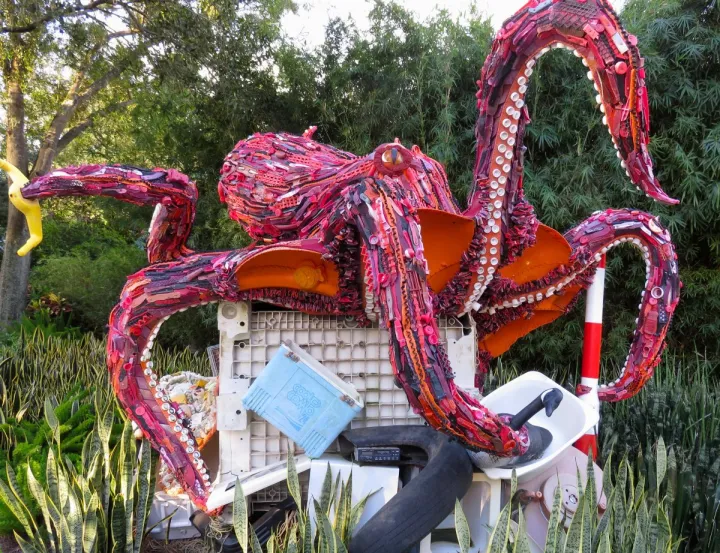Turning Ocean Trash to Treasure

Upon entering the Smithsonian’s National Zoo this summer, visitors can expect a bright greeting from a larger-than-life Priscilla the Parrotfish. Priscilla is a mosaic of every color in the rainbow, but upon further inspection her scales reveal a darker story. In “I-Spy” fashion you can find discarded sand shovels, cigarette lighters, combs, soda bottle caps, mouth guards, and a toothbrush. Priscilla is one of 17 sculptures at the Zoo created and adorned completely by human trash that has been collected off beaches in the Pacific Northwest. Her creators at the Washed Ashore Project hope to spread the word about the global ocean plastic problem and provide a bit of hope by showing that we can make a difference by reducing our plastic consumption.
In the years since its invention in 1907, humans have become addicted to plastic. We wear plastic clothes, drive plastic cars, drink from disposable plastic bottles and play with plastic toys. It is cheap, durable, and comes in every color. Over the past five years, we produced on average between 245 and 300 million tons of plastic each year. That’s roughly 100 times the weight of every elephant (both Asian and African) on the planet. While it is still unclear how much of this plastic makes it into the ocean, scientists estimate the numbers could reach as high as 12.7 million tons annually.
We do know that plastic gets around. Plastic has found its way to the remotest corners of the earth including Antarctica, the Arctic and the deep sea floor. At the surface, plastic gets concentrated in five giant ocean gyres. The one in the northern Pacific, once described as the Pacific garbage patch, is more akin to a plastic soup than a floating island. Animals as small as tiny krill and as large as whales, like the 13 sperm whales that washed ashore this past January, consume plastic in deadly amounts. Most recently, scientists reported that baby fish actually prefer plastic to their normal food and suffer the consequences!
A depressing topic, Washed Ashore aims to refocus the ocean plastics discussion in a more hopeful light. Angela Haseltine Pozzi, the founder and lead artist, began the project as a personal and emotional response to a sick ocean. “I came to the ocean to heal, but soon found an ocean that needed healing," Pozzi says. Over 12,000 volunteers have collected, sorted, washed, and arranged over 17 tons of marine debris, which now make up one of the organization’s 65 and counting sculptures. Fan favorite sea creatures include Lidia the Seal, Octavia the Octopus, and Tula the Sea Turtle, but the giant plastic bottle jellies and whale bone ribcage also leave spectators in awe. Pozzi is a firm believer that a single person has the potential to make a significant impact.
Decided you want to make a difference? World Ocean Day is a great day to begin! You can start with a few simple changes. Reduce plastic use by bringing fabric bags to the grocery store, fill a reusable water bottle, say no to straws and single use plastic, and bring lunch in reusable containers. Challenge yourself to change one habit and then move on to another.
If you want to see these beautiful and moving sculptures for yourself check out the exhibit at the National Museum of Natural History’s Sant Ocean Hall.


